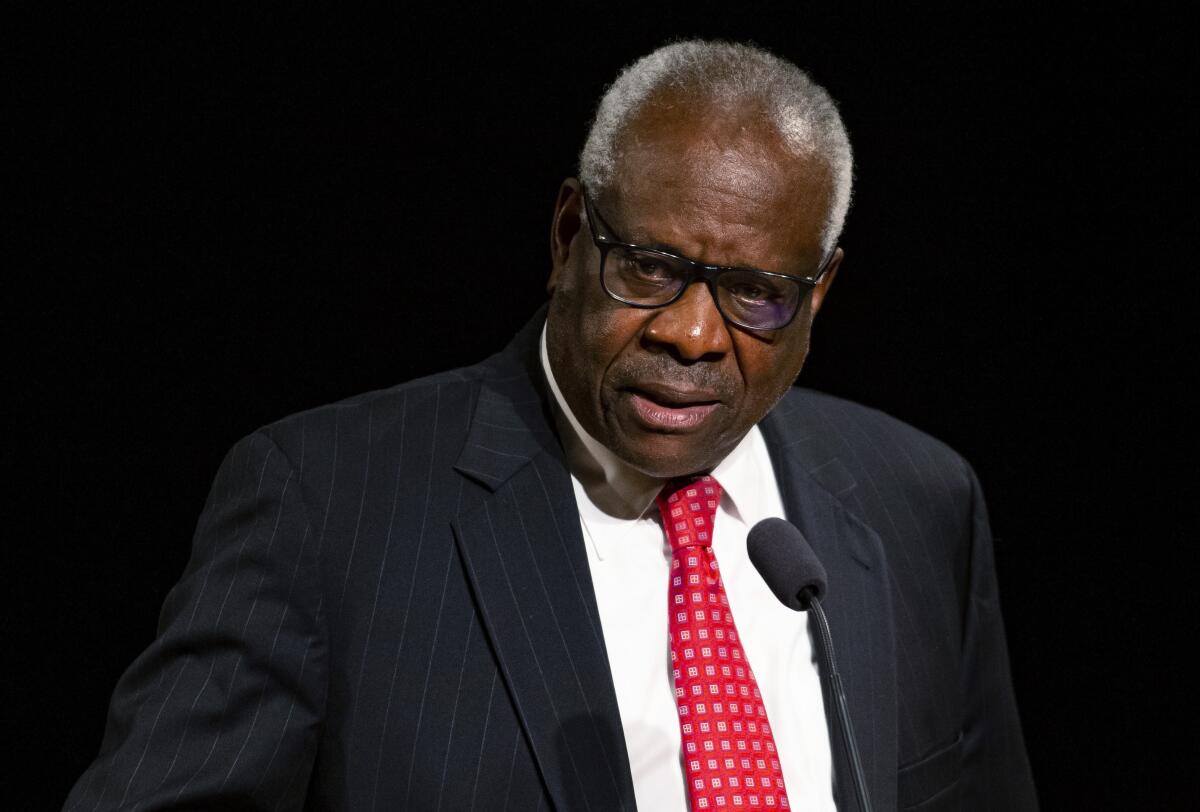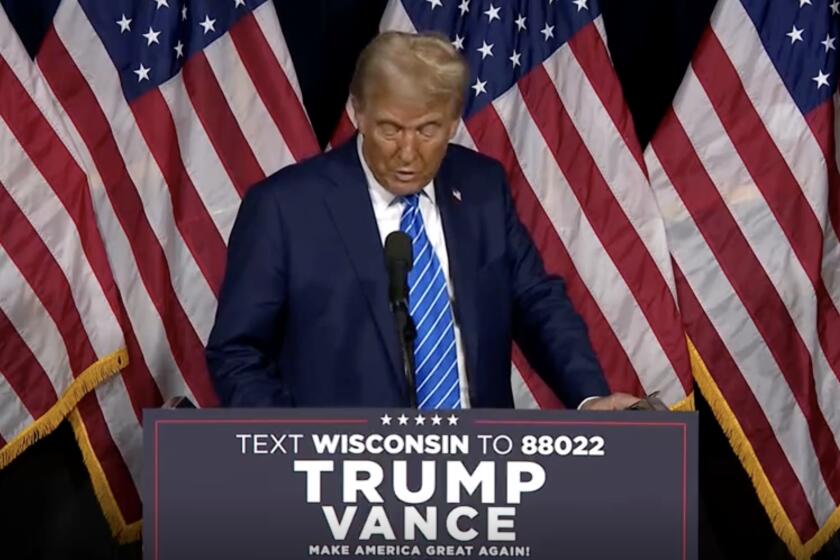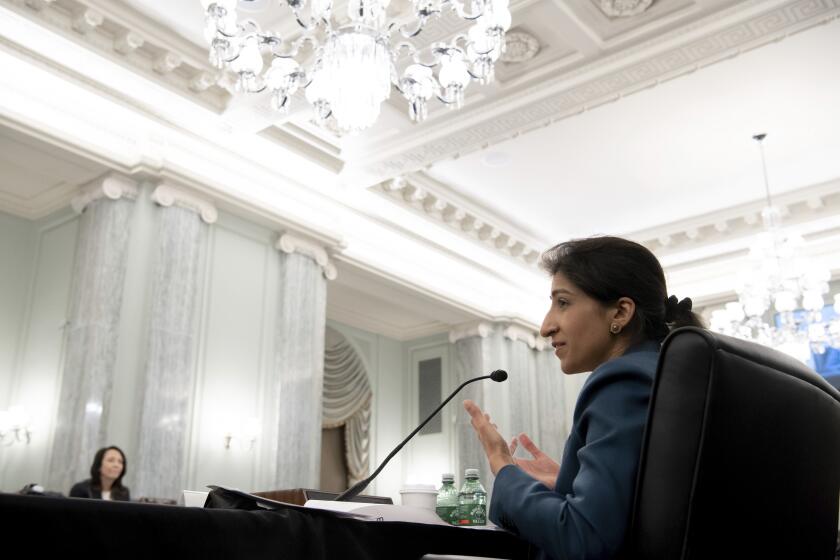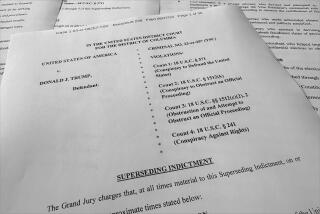Column: A Trump judge just overturned the government’s most effective anti-fraud tool, which has stood for 160 years

- Share via
Since 1986, whistleblowers have been in the forefront of the government’s war on fraud, accounting for $53 billion, or more than 70%, of the $75 billion recovered from swindlers on defense contracts, from Medicare and from other federal programs.
There’s no debate over what’s driving this record: It’s a 1986 federal law that awards whistleblowers up to 30% of the recovery. For the federal government, this is a bargain. Without the law, the government might never even know about most of the $75 billion in fraud that was unearthed.
That makes the law “one of the government’s top fraud-fighting tools,” says James King, a spokesman for the Anti-Fraud Coalition, a Washington watchdog group.
Without the qui tam, the federal government often would never find out about the fraud at all.
— Leonardo Cuello, Georgetown University
So perhaps it’s unsurprising that a Trump-appointed judge in Florida has just declared a key provision of the law unconstitutional. The provision concerns so-called qui tam actions, in which private litigants bring lawsuits on behalf of the government as well as themselves. (The Latin term came to us via old English law.)
The ruling came from federal Judge Kathryn Kimball Mizelle, whom Trump named to the bench in 2020 despite her having been labeled “not qualified” by the American Bar Assn. due to her “lack of meaningful trial experience.” She did, however, boast a sterling right-wing legal pedigree, including service as a law clerk to Supreme Court Justice Clarence Thomas.
Get the latest from Michael Hiltzik
Commentary on economics and more from a Pulitzer Prize winner.
You may occasionally receive promotional content from the Los Angeles Times.
Mizelle is one of a cadre of Republican-appointed regional trial judges who have taken it upon themselves to upend settled government laws and programs by declaring them illegal or unconstitutional.
They include Trump appointee Matthew Kacsmaryk of Amarillo, Texas, who has tried to remove the abortion drug mifepristone from the market (though he was originally unsuccessful, he is getting a second shot at the issue) and Reed O’Connor of Fort Worth, a George W. Bush appointee who tried to declare the entire Affordable Care Act unconstitutional, only to be overruled by the Supreme Court.
All together, they form a cabal armed with lifetime terms and capable of imposing reactionary policies on the American people long after Trump himself has shuffled off the stage.
The current qui tam case, in which physician Clarissa Zafirov accused her employers and related companies of faking and inflating diagnostic codes to increase their Medicare reimbursements, isn’t Mizelle’s first rodeo in the game of overturning government rules and regulations. In 2022 she struck down the Biden administration’s pandemic-era mandate that travelers on planes and public transportation wear masks, even though the Supreme Court had upheld the rule three times.
Trump claims to have saved Obamacare and beaten COVID. The truth is exactly the opposite on both counts.
A few words about the history of the whistleblower provisions. The qui tam rules are part of the False Claims Act, a Civil War-era law that was enacted in response to reports of wholesale plundering by suppliers of military goods and ammo to the War Department. From its inception, the FCA was enforced through a “public-private scheme,” as Supreme Court Justice Elena Kagan wrote in a 2023 decision upholding the law.
The qui tam concept is older than that, however. It dates back to the first Congress, which enacted numerous qui tam laws signed by President Washington. An early heyday for the concept came with the 1794 Slave Trade Act, which provided for a bounty to be paid to private citizens who sued slave traders they found violating a law prohibiting the modification of vessels to transport slaves.
The payments came from forfeitures of slave ships and fines on their owners, with the proceeds divided 50-50 between the government and the litigants. The latter didn’t have to show that they had suffered any harm themselves from the slavers’ activities, which made the 18th century rules “a virtual dead ringer for the FCA’s qui tam provisions,” as the government asserted in a brief in the Zafirov case. Abolitionists made good use of the provision to harry slave traders.
In 1986, Congress amended the False Claims Act to encourage whistleblowers — or “relators,” as they’re known in the law. The amendment increased the relators’ share of recoveries and set forth a procedure for qui tam lawsuits. Here’s how it works: The relators must file their initial lawsuits under seal, notifying the government, but not the targets, of their case. The government then has 60 days to decide whether to intervene in the case.
If it intervenes, it takes over management of the lawsuit though the relator remains a party; the latter can receive 15% to 25% of any recovery. If it declines, relators can continue the lawsuits on their own, shouldering the cost of investigating their charges but becoming eligible for a higher 25% to 30% of any recovery. Either way, the government keeps the balance of the recovered funds.
The NLRB hit Elon Musk’s SpaceX with a raft of labor law charges. A day later, he called the board “unconstitutional” in a lawsuit. Would the Supreme Court side with him?
The government declines to intervene in the majority of qui tam cases. That’s “purely a resource matter,” King told me — the feds simply don’t have the money or manpower to investigate every case of fraud in its programs, so it relies on whistleblowers to carry the charges forward.
The 1986 amendment was chiefly aimed at deterring defense-related fraud — through 2000, King says, more than 85% of whistleblower cases involved military procurement. But since then, about 80% of cases involve accusations against providers to Medicare and Medicaid.
A good example concerned the drug company Biogen, which paid $900 million to the federal and state governments in 2022 to settle a qui tam lawsuit in which a former employee alleged that the company had paid kickbacks to doctors to entice them to prescribe its multiple sclerosis drugs. (The company didn’t admit guilt in the settlement.)
The government had declined to intervene in the lawsuit but praised the relator for having “diligently pursued this matter on behalf of the United States” over a decade. The whistleblower collected about $250 million, or roughly 30% of the federal government’s share of the settlement.
That brings us full circle back to the Zafirov lawsuit. The physician filed her lawsuit in 2019. The government declined to intervene. So for the following five years Zafirov pursued it, until Mizelle threw it out on Sept. 30.
Mizelle asserted that Zafirov was essentially acting as a government officer in bringing and pursuing the case. After all, Mizelle wrote, the physician “has determined which defendants to sue, which theories to raise, which motions to file, and which evidence to obtain.” But because Zafirov had not been appointed by the president, her role violated the “appointments clause” of Article II of the Constitution.
A few things about this argument. First, it tracks closely with the most notable published objection to the qui tam system. That came from Justice Thomas, Mizelle’s mentor. He asserted in a 2023 opinion that “there is good reason to suspect that Article II does not permit private relators to represent the United States’ interests in FCA suits.”
The Federal Trade Commission banned non-compete clauses, which block workers from moving to better jobs. A Trump-appointed judge has blocked it--of course
In that case, Thomas was the sole dissenter in an 8-1 decision. He didn’t state outright that the qui tam provision is unconstitutional but only suggested that it would be a ripe issue for some other lawsuit.
Still, corporate lawyers representing businesses likely to face qui tam lawsuits took heart from his expression of doubt, as well as from comments by Justices Brett Kavanaugh and Amy Coney Barrett, in concurring opinions in the same case, that they’d be open to considering the issue “in an appropriate case.” That makes a possible anti-qui tam bloc of three justices, which is a start.
Yet the fact is that numerous federal judges at the trial and appellate level have heard similar objections to qui tam lawsuits, and rejected them every time — even after Thomas advanced the constitutionality issue. Indeed, only three weeks before Mizelle weighed in, a judge in a neighboring federal court flatly rejected the argument.
That judge, Donald M. Middlebrooks, an appointee of President Clinton, ruled that “relators, private individuals ... have none of the defining qualities of an officer of the United States that must be appointed with the advice and consent of [the] president.” He noted that “they are not in an employment-like relationship with the United States, and they have no permanent or continuing duties,” which would define them as government officers.
Even corporate defense lawyers are wary of regarding Mizelle’s decision as anything but an outlier — for now. No other judge has ever found qui tam provisions to be unconstitutional. The judicial comments that Thomas mined for his comment were all dissents.
UnitedHealth, the nation’s biggest health insurance company, flouted New York law by refusing to cover a patient’s birth control. That’s a sign of how women’s healthcare rights are being whittled away.
“At this point, Zafirov is a district court decision without precedential value,” wrote two corporate lawyers in a recent analysis. But they observed that Zafirov is almost certain to be appealed and more corporate defendants will be using it to get lawsuits against them thrown out. “It is possible if not likely that the constitutionality of the FCA’s qui tam provisions is going to be before the Supreme Court before long,” they wrote.
A successful attack on qui tam lawsuits would mean the end of efforts that brought $53 billion in recoveries over recent decades. That’s only a slice of the $233 billion to $531 billion the government loses to fraud every year, in the estimation of the Government Accountability Office, but it’s not peanuts.
“Without the qui tam, the federal government often would never find out about the fraud at all,” Leonardo Cuello, an expert on Medicaid at Georgetown University, wrote after Mizelle’s ruling. “Ultimately, individuals or companies engaged in fraud (and the lawyers that defend them) will know they can knock out any claim brought alone by a whistleblower. It’s like the robbers finding out that all the cops are on vacation.”
There’s more to it than that. “This fits into the broader category of defanging government so the government can’t do the things we need and want it to do,” Cuello told me. Conservatives have tried to sap the authority of presidents and federal agencies to do their work, and conservative federal judges have helped them do so — blocking public health mandates during the pandemic and efforts by the Biden administration to relieve the burden of student debt, among other things.
When they haven’t been able to defeat government actions at the congressional level, they’ve tried to do so by challenging the authority of executive branch agencies. They’ve challenged the constitutionality of the Consumer Financial Protection Bureau and the National Labor Relations Board (the latter challenge launched by that noted defender of the rule of law and of regulation, Elon Musk).
In other words, it would be wise to think of Mizelle’s ruling as a canary in the coal mine. Big business has been trying to eviscerate anti-fraud laws for more than a century. They may finally be in with a chance.
More to Read
Get the latest from Michael Hiltzik
Commentary on economics and more from a Pulitzer Prize winner.
You may occasionally receive promotional content from the Los Angeles Times.















